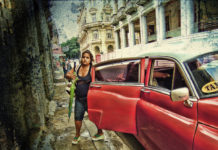
Last week in Nicaragua, Momotombo volcano awakened from its 110-year slumber with a fierce explosion of fire, ash, rock, sulphur, and noise. Sending a pillar of dense black smoke one kilometer into the sky, the volcano released a pulsing, incandescent fountain of lava, which bled down its slopes in a single narrow stream.
Images and videos of the entrancing ‘Strombolian’ eruption – a type of noisy, explosive eruption caused by bursting gas bubbles (named after Stromboli volcano in Italy) – quickly circulated on social media. From National Geographic to Wired, it drew the admiration of numerous international news outlets.
Momotombo volcano is situated on the northwest shores of Lake Managua, approximately 100 kilometers from the capital. It is the southernmost cone in the Maribios volcano range, a rocky spine of 21 volcanic peaks which run as far north as the Cosigüina Peninsula near the border with Honduras and El Salvador. The Maribios, together with the entire Pacific coast of Central America, belong to a zone of lively seismic activity at the juncture of the Cocos and Caribbean tectonic plates.
“Momotombo blew her top.”
Since its last big eruption in 1905, Momotombo had lain dormant with only the occasional emission of steam and ash to hint at any tempestuous activity beneath the earth’s surface. According to El Nuevo Diario, about two weeks ago, local residents began experiencing a series of tremors, until finally, late in the evening of 30 November, Momotombo blew her top. Fortunately, no one was hurt.
Writing for Wired, volcanologist Erik Klemetti from Denison University suggested the eruption may have been “the culmination of over a decade’s worth of priming in the magmatic system.”
Momotombo, prior to 1905, was highly active and prone to regular violent outbursts. In 1610, its cataclysmic hail of burning rock and ash forced inhabitants of Léon Viejo, the then colonial capital of the region, to relocate their city 30 miles west to its present location.
Perfectly symmetrical and pleasingly poised by bucolic waters, Momotombo has long been the national symbol of Nicaragua. It has inspired generations of national and international poets, including Rubén Dario, who penned several verses in homage to her. Its name in Nahautl means ‘great boiling summit’. The Chortega living at its base called it ‘Mamea’, ‘the fireplace’.
In 1902, an old postage stamp depicting Momotombo erupting was instrumental in the United States decision to reject plans for a transoceanic canal in Nicaragua.
Canal plans
At the time, the U.S. was debating whether to purchase the failed French canal in Panama or to build a new one in Nicaragua. Philipe Bunau-Varilla, a crafty French engineer and ex-soldier who was heavily invested in the defunct Panama Canal Company, sent postcards affixed with the stamp to U.S. senators. This was enough to convince them that Nicaragua was too seismically unstable for such a project. Panama won the contract, and the rest is history.
Although dramatic, the spectacle of Momotombo’s latest eruption is unlikely to impact present-day plans to build a Nicaragua canal. The latest images from the scene show the giant has again returned to a state of rest, albeit smouldering and somewhat scarred.
Source: Latin Correspondent [Archived]
Image: Photovolcanica










